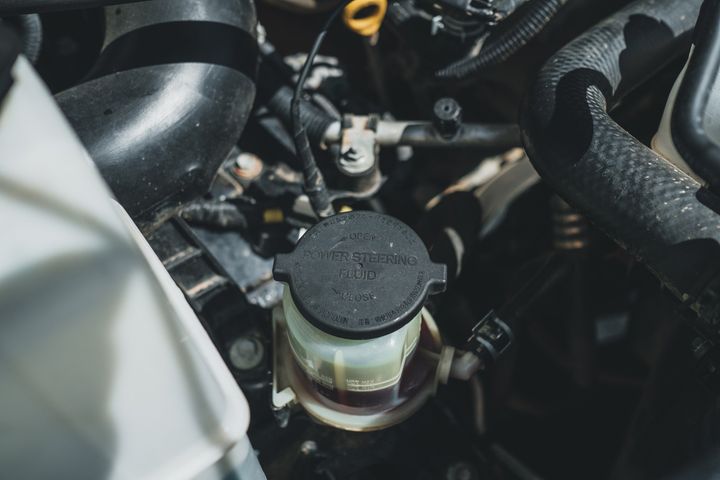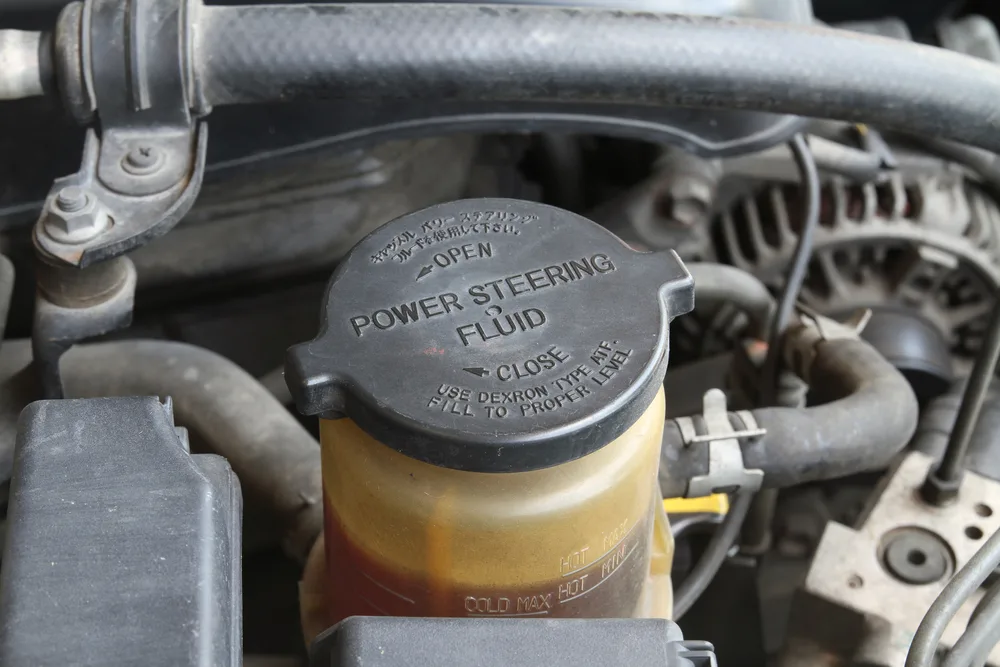


Maintaining your vehicle's power steering system is crucial for smooth and responsive steering, and one of the key components that require regular attention is the power steering reservoir. This comprehensive guide will provide you with an in-depth understanding of the importance of cleaning the power steering reservoir, the necessary steps involved, and the benefits of proper maintenance.

The power steering system is a hydraulic system that assists in turning the steering wheel, making it easier to maneuver your vehicle, especially at low speeds or during tight turns. The power steering reservoir plays a vital role in this system by storing and supplying the hydraulic fluid that powers the steering components.
Here's a table outlining the main components of the power steering system:
| Component | Description |
|---|---|
| Power Steering Pump | Generates the hydraulic pressure required for the system to function. |
| Power Steering Reservoir | Holds the hydraulic fluid and supplies it to the pump. |
| Steering Gear or Rack | Translates the hydraulic pressure into mechanical force, allowing the wheels to turn. |
| Hoses and Lines | Connect the various components, allowing the hydraulic fluid to circulate throughout the system. |
Neglecting the power steering reservoir can lead to several issues, including:
Contamination: Dirt, debris, and moisture can enter the reservoir, contaminating the hydraulic fluid and causing damage to the system's components.
Fluid Depletion: Leaks or improper fluid levels can result in insufficient hydraulic pressure, leading to steering difficulties and potential component failure.
Corrosion: Exposure to contaminants can cause corrosion within the reservoir and other system components, compromising their integrity and lifespan.
By regularly cleaning and maintaining the power steering reservoir, you can ensure the smooth operation of the power steering system, extend its lifespan, and avoid costly repairs.
Before beginning the cleaning process, it's essential to gather the necessary tools and materials, and take the appropriate safety precautions.
To clean the power steering reservoir effectively, you'll need the following:
Rags or shop towels
Degreaser or brake cleaner
Funnel
Compatible power steering fluid (check your owner's manual for the recommended type)
Gloves and safety glasses
Working with automotive fluids and cleaning agents can be hazardous if proper safety measures are not taken. Here are some essential safety precautions to follow:
Work in a well-ventilated area to avoid inhaling fumes.
Wear gloves and safety glasses to protect your hands and eyes from exposure to fluids and chemicals.
Dispose of used fluids and cleaning materials properly, following local regulations.
Keep the work area clean and free from clutter to prevent slips and falls.
Now that you've gathered the necessary tools and materials and taken the appropriate safety precautions, it's time to begin the cleaning process.

The power steering reservoir is typically located near the engine compartment, often on the driver's side or near the firewall. Consult your vehicle's owner's manual or repair guide for the exact location.
With the engine off and cool, locate the reservoir cap and remove it carefully.
Using a clean rag or shop towel, wipe away any dirt or debris around the reservoir opening.
If the reservoir has a drain plug, remove it and allow the old fluid to drain completely. If there is no drain plug, use a turkey baster or similar tool to remove as much of the old fluid as possible.
Once the reservoir is drained, flush it with a degreaser or brake cleaner to remove any remaining contaminants or sludge buildup.
Rinse the reservoir thoroughly with clean water to remove any residual cleaning agents.
Using a clean funnel, refill the reservoir with the recommended power steering fluid, following the manufacturer's specifications for the correct fluid level.
Replace the reservoir cap securely, ensuring it is properly tightened.
If you removed a drain plug, reinstall it and tighten it according to the manufacturer's torque specifications.
Start the engine and check for any leaks around the reservoir or other components of the power steering system.
Top up the fluid level if necessary, and check for any unusual noises or steering issues during a brief test drive.
Cleaning the power steering reservoir is an essential part of regular maintenance, but it's also crucial to follow some best practices to ensure the longevity of the system.
Regularly inspecting the power steering reservoir is essential for identifying potential issues before they become more significant problems. During each inspection, check the following:
| Inspection Point | Description |
|---|---|
| Fluid Level | Ensure the fluid level is within the recommended range, and top up if necessary. |
| Fluid Condition | Check for any discoloration, contamination, or signs of degradation, which may indicate the need for a fluid change. |
| Reservoir Condition | Inspect the reservoir for any cracks, leaks, or signs of corrosion, which could compromise its integrity. |
Power steering fluid degrades over time due to heat, moisture, and contaminants. It's essential to follow the manufacturer's recommended intervals for changing the fluid to ensure optimal performance and prevent damage to the system's components.
If you notice any leaks in the power steering system, it's crucial to address them promptly. Leaks can lead to fluid loss, contamination, and potential component failure if left unattended.
Maintaining the power steering reservoir is not only essential for the smooth operation of the system but also offers several benefits:
Improved Steering Performance: Clean fluid and a well-maintained reservoir contribute to responsive and precise steering, enhancing your driving experience.
Extended Component Lifespan: Regular maintenance helps prevent premature wear and tear on the system's components, reducing the need for costly repairs or replacements.
Increased Vehicle Safety: A properly functioning power steering system ensures better control and maneuverability, especially in emergency situations or tight turns.
Cost Savings: Preventive maintenance is often more cost-effective than dealing with the consequences of neglect, such as component failures or complete system replacements.
Cleaning the power steering reservoir is a straightforward DIY task that can have a significant impact on the performance and longevity of your vehicle's power steering system. By following the steps outlined in this guide, gathering the necessary tools and materials, and adhering to safety precautions, you can ensure smooth and responsive steering while avoiding costly repairs. Regular maintenance and timely fluid changes are also crucial for maintaining the overall health of the power steering system. Invest in the care of your vehicle, and enjoy the benefits of a well-maintained power steering reservoir for years to come.
Dirt, debris, and moisture can enter the reservoir, contaminating the hydraulic fluid. Exposure to contaminants can also cause corrosion within the reservoir and other system components.
Check for discoloration, contamination, or signs of degradation in the fluid, which may indicate the need for a fluid change. Also, follow the manufacturer's recommended intervals for changing the fluid.
No, you must use the type of power steering fluid recommended by the vehicle manufacturer, as specified in the owner's manual.
Neglecting the power steering reservoir can lead to contamination, fluid depletion, and corrosion, which can cause damage to the system's components and potential failure.
Regularly inspecting the power steering reservoir is essential for identifying potential issues before they become more significant problems. Check it during routine maintenance intervals.
Work in a well-ventilated area, wear gloves and safety glasses, and dispose of used fluids and cleaning materials properly.
Yes, you can use a degreaser or brake cleaner to flush the reservoir and remove any remaining contaminants or sludge buildup.
If you notice any leaks in the power steering system, address them promptly to prevent fluid loss, contamination, and potential component failure.
Driving with a low power steering fluid level can lead to steering difficulties and potential component failure, so it's best to top up the fluid level as soon as possible.
Proper maintenance improves steering performance, extends component lifespan, increases vehicle safety, and can save you money by preventing costly repairs or replacements.

Sarah isn't your average gearhead. With a double major in Mechanical Engineering and Automotive Technology, she dived straight into the world of car repair. After 15 years of turning wrenches at dealerships and independent shops, Sarah joined MICDOT to share her expertise and passion for making cars run like new. Her in-depth knowledge and knack for explaining complex issues in simple terms make her a valuable asset to our team.



